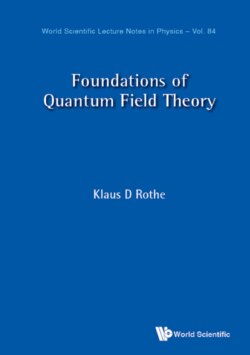Читать книгу Foundations of Quantum Field Theory - Klaus D Rothe - Страница 11
На сайте Литреса книга снята с продажи.
2.1Defining properties of Lorentz transformations
ОглавлениеHomogeneous Lorentz transformations are linear transformations on the space-time coordinates,1
leaving the quadratic form
invariant. Any 4-tuplet transforming like the coordinates in (2.1) is called a contravariant 4-vector. In particular, energy and momentum of a particle are components of a 4-vector
with
The same transformation law defines 4-vector fields at a given physical point:
Note that the quadruple (Λx)μ referred to is the same point as the quadruple xμ referred to ′. Thus, alternatively
Notice that (2.4) and (2.5) represent inverse transformations of the reference frame, respectively. Examples are provided by the 4-vector current and the vector potential of electrodynamics in a Lorentz-covariant gauge.
The differential element dxμ transforms like
Hence it also transforms like a contravariant 4-vector, since
The partial derivative , on the other hand, transforms differently. The usual chain rule of differentiation gives
From the inversion of (2.1) it follows that
Hence for the partial derivative we have the transformation law
Four-tuples which transform like the partial derivative are called covariant 4-vectors. Contravariant and covariant 4-vectors are obtained from each other by raising and lowering the indices with the aid of the metric tensors gμν and gμν, defined by2
respectively, in terms of which the invariant element of length (2.2) can be written in the form
The requirement that ds2 be a Lorentz invariant
now implies
Thus the metric gμν is said to be a Lorentz-invariant tensor. It is convenient to write this equation in matrix notation by grouping the elements into a matrix as follows:
Defining the elements of the transpose matrix ΛT by
we can write (2.8) as follows:
From here we obtain for the inverse Λ−1,
or in terms of components
Define the dual to a contravariant 4-vector vμ by
Thus gμν(gμν) serve to lower (raise) the Lorentz indices. In particular . We have after a Lorentz transformation, upon using (2.9)
or we conclude that vμ defined by (2.10) does indeed transform like a covariant 4-vector. In particular we see that the following 4-tuplets transform like covariant and contravariant 4-vectors, respectively:
where
